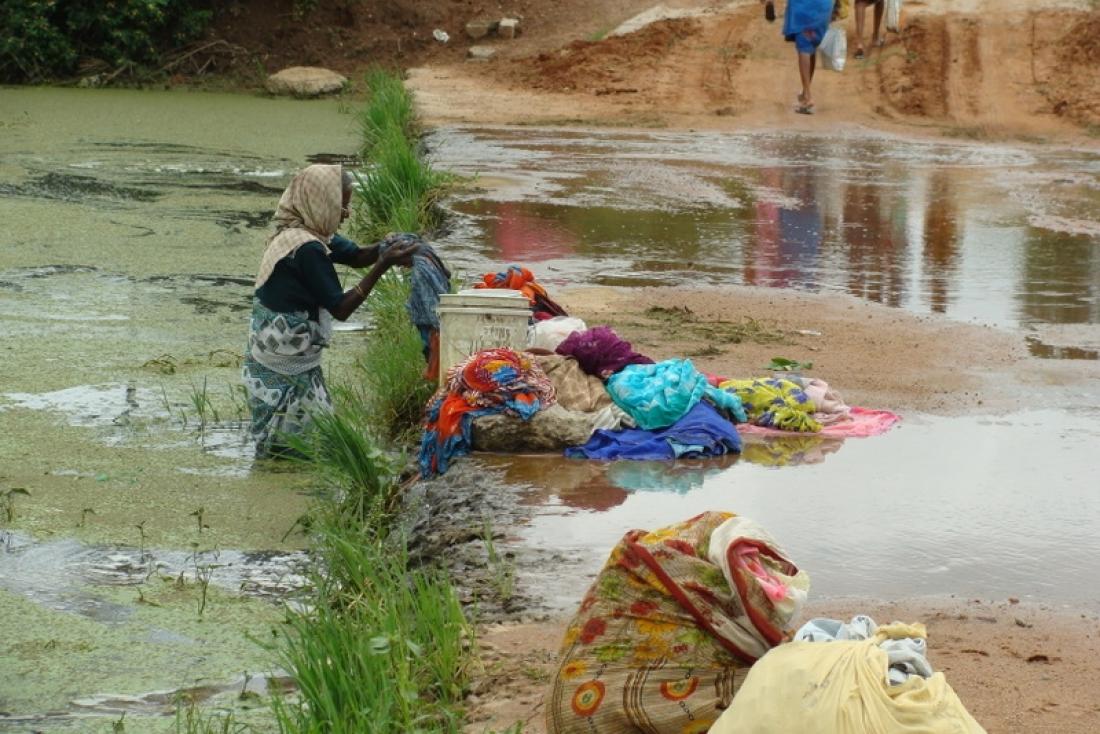A woman washes clothes in a man-made channel in peri-urban Hyderabad, India.
Research focus
-------------------
To explore how growing cities and a changing climate affect water security in peri-urban South Asia and find fair and sustainable solutions.
The challenge
------------------
South Asia is rapidly urbanizing. The cities of India alone are expected to swell by more than 200 million people in the next 15 years. Dhaka, the capital of neighbouring Bangladesh, is the world’s fastest growing megacity. As cities spread out, consuming more land and water, the communities around them experience many of the associated growing pains. Water scarcity particularly concerns residents of these peri-urban areas. Climate change compounds the problem as it affects hydrology across the subcontinent, from rising sea levels in the Bay of Bengal, to melting Himalayan glaciers, and erratic monsoons.
Sustainable and equitable water distribution is especially challenging on the edges of cities. Neither urban nor rural, these communities often fall between the cracks of neighbouring jurisdictions and are caught between competing demands for resources from thirsty cities and traditional ways of life.
How urban growth takes place in a region that is home to 20% of the world’s population will tremendously affect millions of lives and the planet as a whole.
To better understand the growing threats to water security and help communities adapt, Canada’s International Development Research Centre supported the South Asia Water Consortium, made up of local research organizations.
The research
-----------------
Beginning in July 2010, teams spent six months studying water security in four diverse sites in three countries, chosen to reflect South Asia’s wide range of social and environmental conditions: Khulna, Bangladesh; Kathmandu, Nepal; and Hyderabad and Gurgaon, India.
Climate change was found to affect water security the most in Khulna. Located near the Bay of Bengal, Bangladesh’s third largest city relies exclusively on groundwater, which is showing higher levels of salinification as sea levels rise. Unplanned growth and rapid industrial development around the city are polluting water sources and have led to an increase in water-borne diseases.
Demand for water is growing in peri-urban Kathmandu, leading some farmers to abandon agriculture and sell the groundwater under their farms to private companies. Runoff from unregulated sand mining is also harming agriculture. Together these unsustainable practices are lowering the water table and threaten food security. As demand for water outpaces supply, violent conflicts have erupted over competing water uses.
Farmers in Gurgaon, a booming satellite of India’s capital Delhi, are also selling the water under their land. Water tables are being further depleted as high-rise housing units sprout up on farmers’ fields, preventing the groundwater from being replenished. As agriculture becomes more marginal, landlords rent their lands to poorer farmers. Changing rainfall patterns, which caused severe flooding in Pakistan in 2010, are reducing harvests. Under sharecropping arrangements, however, tenant farmers must pay the same rent whether or not their crops fail.
Hyderabad in Southern India is famous for its series of artificial lakes, created as water reservoirs. “These were very effective systems for managing water flows,” says IDRC project leader Sara Ahmed. These lakes are now threatened by real estate developments, which have paved over some lakes and consume a disproportionate share of local water resources.
Expected impact
----------------------
The preliminary research across four urban areas is providing a better understanding of peri-urban environments and how they function. Rather than a location, these places are defined by processes and changes, including land use patterns, the mixing of social groups, and competing uses for resources.
Researchers are also learning more about the unequal impact development and climate change have on different social groups. From uninsured tenant farmers in Gurgaon, to villagers cut off from lakes in Hyderabad, to women in Khulna who must travel further to collect clean water — gender, caste, and class inequality all contribute to water insecurity.
The research teams are communicating with each other – and the world – through a website, blog, Facebook, and Flickr, as well as on a twitter feed.
Armed with their growing understanding of the social, economic, and environmental factors that contribute to water insecurity in each peri-urban area, the teams are now developing solutions that will engage marginalized groups, governments, and the private sector to work toward ensuring clean water for all.
Jonah Engle is a Montréal-based writer.
This article profiles a project supported by IDRC’s Climate Change and Water program, Water Security in Periurban South Asia: Adapting to Climate Change and Urbanization.



